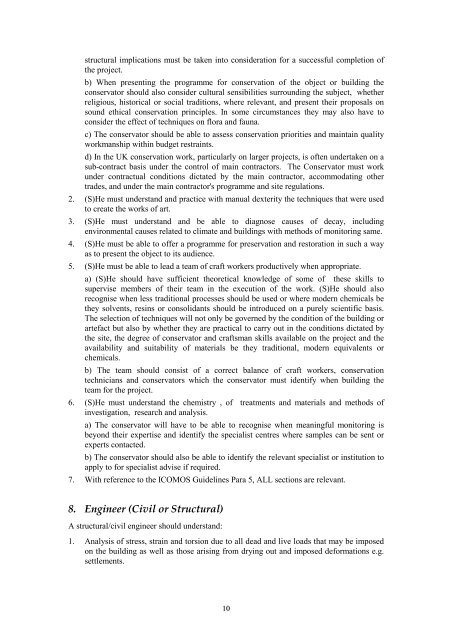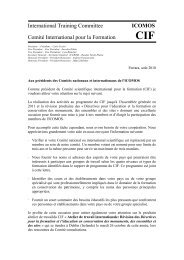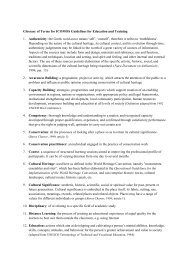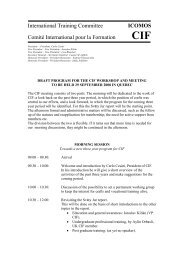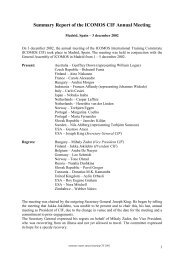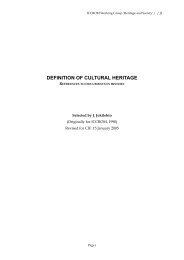COTAC Conference on Training in Architectural Conservation Multi ...
COTAC Conference on Training in Architectural Conservation Multi ...
COTAC Conference on Training in Architectural Conservation Multi ...
You also want an ePaper? Increase the reach of your titles
YUMPU automatically turns print PDFs into web optimized ePapers that Google loves.
structural implicati<strong>on</strong>s must be taken <strong>in</strong>to c<strong>on</strong>siderati<strong>on</strong> for a successful completi<strong>on</strong> of<br />
the project.<br />
b) When present<strong>in</strong>g the programme for c<strong>on</strong>servati<strong>on</strong> of the object or build<strong>in</strong>g the<br />
c<strong>on</strong>servator should also c<strong>on</strong>sider cultural sensibilities surround<strong>in</strong>g the subject, whether<br />
religious, historical or social traditi<strong>on</strong>s, where relevant, and present their proposals <strong>on</strong><br />
sound ethical c<strong>on</strong>servati<strong>on</strong> pr<strong>in</strong>ciples. In some circumstances they may also have to<br />
c<strong>on</strong>sider the effect of techniques <strong>on</strong> flora and fauna.<br />
c) The c<strong>on</strong>servator should be able to assess c<strong>on</strong>servati<strong>on</strong> priorities and ma<strong>in</strong>ta<strong>in</strong> quality<br />
workmanship with<strong>in</strong> budget restra<strong>in</strong>ts.<br />
d) In the UK c<strong>on</strong>servati<strong>on</strong> work, particularly <strong>on</strong> larger projects, is often undertaken <strong>on</strong> a<br />
sub-c<strong>on</strong>tract basis under the c<strong>on</strong>trol of ma<strong>in</strong> c<strong>on</strong>tractors. The C<strong>on</strong>servator must work<br />
under c<strong>on</strong>tractual c<strong>on</strong>diti<strong>on</strong>s dictated by the ma<strong>in</strong> c<strong>on</strong>tractor, accommodat<strong>in</strong>g other<br />
trades, and under the ma<strong>in</strong> c<strong>on</strong>tractor's programme and site regulati<strong>on</strong>s.<br />
2. (S)He must understand and practice with manual dexterity the techniques that were used<br />
to create the works of art.<br />
3. (S)He must understand and be able to diagnose causes of decay, <strong>in</strong>clud<strong>in</strong>g<br />
envir<strong>on</strong>mental causes related to climate and build<strong>in</strong>gs with methods of m<strong>on</strong>itor<strong>in</strong>g same.<br />
4. (S)He must be able to offer a programme for preservati<strong>on</strong> and restorati<strong>on</strong> <strong>in</strong> such a way<br />
as to present the object to its audience.<br />
5. (S)He must be able to lead a team of craft workers productively when appropriate.<br />
a) (S)He should have sufficient theoretical knowledge of some of these skills to<br />
supervise members of their team <strong>in</strong> the executi<strong>on</strong> of the work. (S)He should also<br />
recognise when less traditi<strong>on</strong>al processes should be used or where modern chemicals be<br />
they solvents, res<strong>in</strong>s or c<strong>on</strong>solidants should be <strong>in</strong>troduced <strong>on</strong> a purely scientific basis.<br />
The selecti<strong>on</strong> of techniques will not <strong>on</strong>ly be governed by the c<strong>on</strong>diti<strong>on</strong> of the build<strong>in</strong>g or<br />
artefact but also by whether they are practical to carry out <strong>in</strong> the c<strong>on</strong>diti<strong>on</strong>s dictated by<br />
the site, the degree of c<strong>on</strong>servator and craftsman skills available <strong>on</strong> the project and the<br />
availability and suitability of materials be they traditi<strong>on</strong>al, modern equivalents or<br />
chemicals.<br />
b) The team should c<strong>on</strong>sist of a correct balance of craft workers, c<strong>on</strong>servati<strong>on</strong><br />
technicians and c<strong>on</strong>servators which the c<strong>on</strong>servator must identify when build<strong>in</strong>g the<br />
team for the project.<br />
6. (S)He must understand the chemistry , of treatments and materials and methods of<br />
<strong>in</strong>vestigati<strong>on</strong>, research and analysis.<br />
a) The c<strong>on</strong>servator will have to be able to recognise when mean<strong>in</strong>gful m<strong>on</strong>itor<strong>in</strong>g is<br />
bey<strong>on</strong>d their expertise and identify the specialist centres where samples can be sent or<br />
experts c<strong>on</strong>tacted.<br />
b) The c<strong>on</strong>servator should also be able to identify the relevant specialist or <strong>in</strong>stituti<strong>on</strong> to<br />
apply to for specialist advise if required.<br />
7. With reference to the ICOMOS Guidel<strong>in</strong>es Para 5, ALL secti<strong>on</strong>s are relevant.<br />
8. Eng<strong>in</strong>eer (Civil or Structural)<br />
A structural/civil eng<strong>in</strong>eer should understand:<br />
1. Analysis of stress, stra<strong>in</strong> and torsi<strong>on</strong> due to all dead and live loads that may be imposed<br />
<strong>on</strong> the build<strong>in</strong>g as well as those aris<strong>in</strong>g from dry<strong>in</strong>g out and imposed deformati<strong>on</strong>s e.g.<br />
settlements.<br />
10


